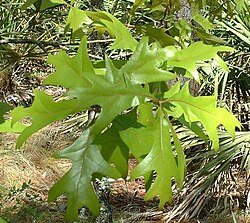- Turkey oak trees
- A stand of turkey oaks growing on white sand near the banks of the Ocmulgee River in the state of Georgia
| Quercus laevis | |
|---|---|
 | |
| American turkey oak foliage | |
| Scientific classification | |
| Kingdom: | Plantae |
| Clade: | Tracheophytes |
| Clade: | Angiosperms |
| Clade: | Eudicots |
| Clade: | Rosids |
| Order: | Fagales |
| Family: | Fagaceae |
| Genus: | Quercus |
| Subgenus: | Quercus subg. Quercus |
| Section: | Quercus sect. Lobatae |
| Species: | Q. laevis |
| Binomial name | |
| Quercus laevis | |
 | |
| Quercus laevis native range | |
| Synonyms [2] | |
| |
Quercus laevis, the turkey oak, is a member of the red oak group of oaks. It is native to the southeastern United States. The name turkey oak derives from the resemblance of the leaves to a turkey's foot. [3] A Turkish and southern European species Quercus cerris is also commonly referred to as Turkey oak, so Quercus laevis is sometimes referred to as American turkey oak to distinguish it from the European species.


